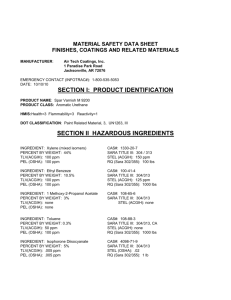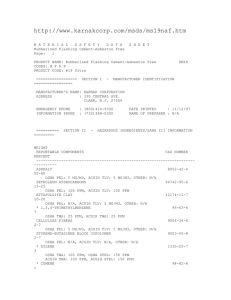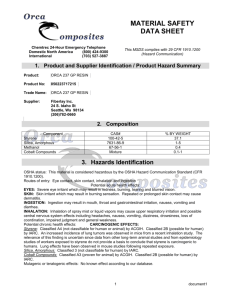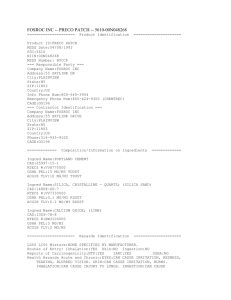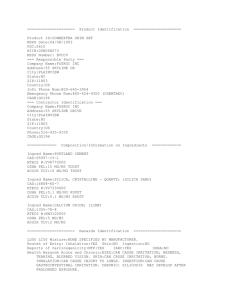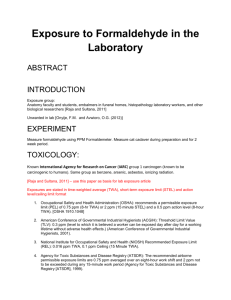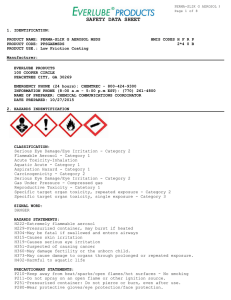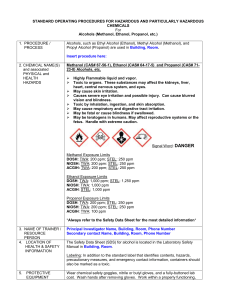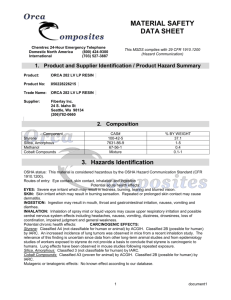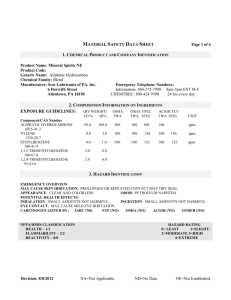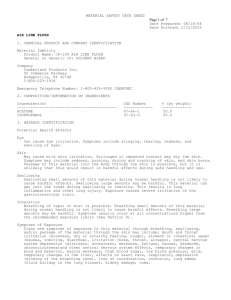Chemical Name: Macmillan 140 Safety Solvent
advertisement
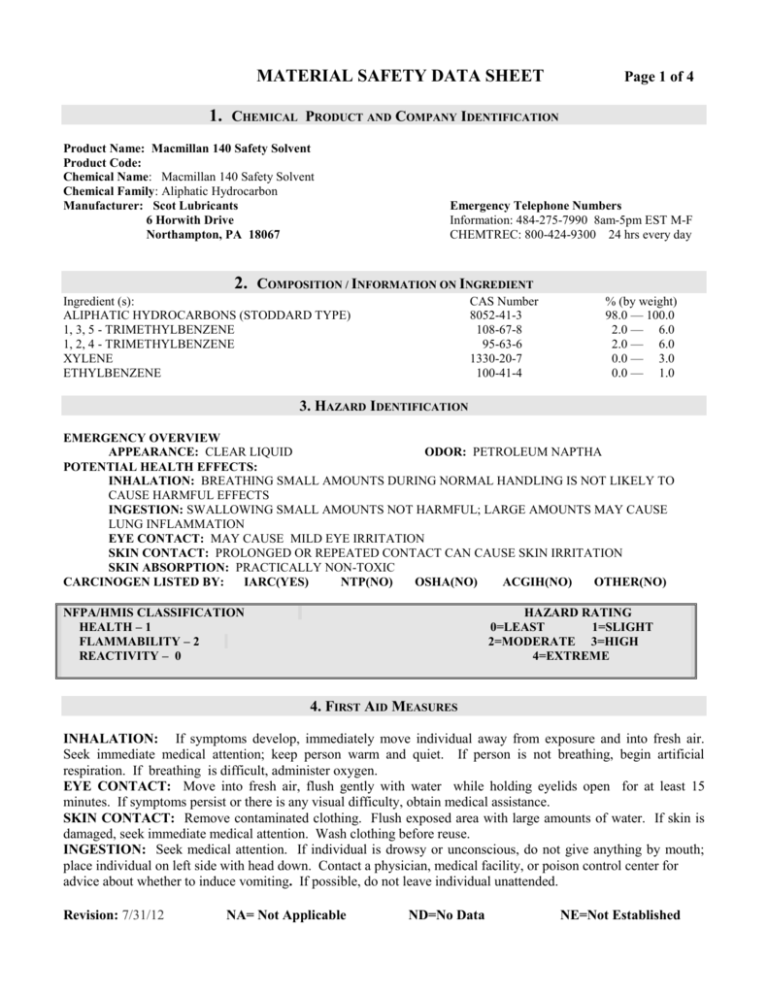
MATERIAL SAFETY DATA SHEET Page 1 of 4 1. CHEMICAL PRODUCT AND COMPANY IDENTIFICATION Product Name: Macmillan 140 Safety Solvent Product Code: Chemical Name: Macmillan 140 Safety Solvent Chemical Family: Aliphatic Hydrocarbon Manufacturer: Scot Lubricants 6 Horwith Drive Northampton, PA 18067 Emergency Telephone Numbers Information: 484-275-7990 8am-5pm EST M-F CHEMTREC: 800-424-9300 24 hrs every day 2. COMPOSITION / INFORMATION ON INGREDIENT Ingredient (s): ALIPHATIC HYDROCARBONS (STODDARD TYPE) 1, 3, 5 - TRIMETHYLBENZENE 1, 2, 4 - TRIMETHYLBENZENE XYLENE ETHYLBENZENE CAS Number 8052-41-3 108-67-8 95-63-6 1330-20-7 100-41-4 % (by weight) 98.0 — 100.0 2.0 — 6.0 2.0 — 6.0 0.0 — 3.0 0.0 — 1.0 3. HAZARD IDENTIFICATION EMERGENCY OVERVIEW APPEARANCE: CLEAR LIQUID ODOR: PETROLEUM NAPTHA POTENTIAL HEALTH EFFECTS: INHALATION: BREATHING SMALL AMOUNTS DURING NORMAL HANDLING IS NOT LIKELY TO CAUSE HARMFUL EFFECTS INGESTION: SWALLOWING SMALL AMOUNTS NOT HARMFUL; LARGE AMOUNTS MAY CAUSE LUNG INFLAMMATION EYE CONTACT: MAY CAUSE MILD EYE IRRITATION SKIN CONTACT: PROLONGED OR REPEATED CONTACT CAN CAUSE SKIN IRRITATION SKIN ABSORPTION: PRACTICALLY NON-TOXIC CARCINOGEN LISTED BY: IARC(YES) NTP(NO) OSHA(NO) ACGIH(NO) OTHER(NO) NFPA/HMIS CLASSIFICATION HEALTH – 1 FLAMMABILITY – 2 REACTIVITY – 0 HAZARD RATING 0=LEAST 1=SLIGHT 2=MODERATE 3=HIGH 4=EXTREME 4. FIRST AID MEASURES INHALATION: If symptoms develop, immediately move individual away from exposure and into fresh air. Seek immediate medical attention; keep person warm and quiet. If person is not breathing, begin artificial respiration. If breathing is difficult, administer oxygen. EYE CONTACT: Move into fresh air, flush gently with water while holding eyelids open for at least 15 minutes. If symptoms persist or there is any visual difficulty, obtain medical assistance. SKIN CONTACT: Remove contaminated clothing. Flush exposed area with large amounts of water. If skin is damaged, seek immediate medical attention. Wash clothing before reuse. INGESTION: Seek medical attention. If individual is drowsy or unconscious, do not give anything by mouth; place individual on left side with head down. Contact a physician, medical facility, or poison control center for advice about whether to induce vomiting. If possible, do not leave individual unattended. Revision: 7/31/12 NA= Not Applicable ND=No Data NE=Not Established Macmillan 140 Safety Solvent Page 2 of 4 SYMPTOMS OF EXPOSURE: Signs and symptoms of exposure to this material through breathing, swallowing, and/or passage of the material through the skin may include: redness of the face and neck, mouth and throat irritation (soreness, dry or scratchy feeling, cough), stomach or intestinal upset (nausea, vomiting, diarrhea), irritation (nose, throat, airways), tight feeling in the chest, central nervous system excitation (giddiness, liveliness, light-headed feeling) followed by central nervous system depression (dizziness, drowsiness, weakness, fatigue, nausea, headache, unconsciousness) and other central nervous system effects, respiratory depression (slowing of the breathing rate), shortness of breath, loss of coordination, confusion, irregular heartbeat, narcosis (dazed or sluggish feeling), respiratory failure, coma. Primary route of entry: Inhalation, skin absorption, skin contact, eye contact, ingestion. 5. FIRE AND EXPLOSION FLASHPOINT: 105.0 F (40.5) C) TCC EXPLOSIVE LIMIT: (for product) Lower 1.0 Upper 6.0 %5 AUTO-IGNITION TEMP: 535.0 F (279.4) C) EXTINGUISHING MEDIA: Regular foam, carbon dioxide, dry chemical. FIRE AND EXPLOSION HAZARDS: Vapors are heavier than air and may travel along the ground or be moved by ventilation and ignited by heat, pilot lights, other flames and ignition sources at locations distant from material handling point. Never use welding or cutting torch on or near drum (even empty) because product (even just residue) can ignite explosively. FIRE FIGHTING INSTRUCTIONS: Wear a self-contained breathing apparatus with a full facepieces operated in the positive pressure demand mode with appropriate turnout gear and chemical resistant personal protective equipment. Refer to the personal protective equipment section of this MSDS. 6. ACCIDENTAL RELEASE MEASURES SPILLS: Small Spill: Absorb liquid on vermiculite, floor absorbent or other absorbent material Large Spill: Eliminate all ignition sources (flares, flames including pilot lights, electrical sparks). Persons not wearing protective equipment should be excluded from area or spill until clean up has been completed. Stop spill at source. Prevent from entering drains, sewers, streams or other bodies of water. Prevent from spreading. If runoff occurs, notify authorities as required. Pump or vacuum transfer spilled product to clean containers for recovery. Absorb unrecoverable product. Transfer contaminated absorbent, soil and other materials to containers for disposal. Prevent runoff to sewers, streams or other bodies of water. If runoff occurs, notify proper authorities as required, that a spill has occurred. 7. EMERGENCY AND FIRST AID INHALATION: Remove individual (s) to fresh air. EYE CONTACT: Flush with water 15 minutes. SKIN CONTACT: Wash with soap and water. INGESTION: Contact physician immediately. Do not induce vomiting. NOTE TO PHYSICIAN: Inhalation of high concentrations of this material, as could occur in enclosed spaces or during deliberate abuse, may be associated with cardiac arrhythmias. Sympathomimetic drugs may initiate cardiac arrhythmias in persons exposed to this material. This material is an aspiration hazard. Potential danger from aspiration must be weighed against possible oral toxicity (see Section 4 – Ingestion) when deciding whether to induce vomiting. Preexisting disorders of the following organs (or organ systems) may be aggravated by exposure to this material: skin, lung (for example, asthma-like conditions), liver, kidney, central nervous system, male reproductive system, immune system, auditory system. Individuals with preexisting heart disorders may be more susceptible to arrhythmias (irregular heartbeats) if exposed to high concentrations of this material. 8. EXPOSURE CONTROLS/PERSONAL PROTECTION VENTILATION: Provide sufficient mechanical (general and/or local exhaust) ventilation to maintain exposure below TLV(s). EYE PROTECTION: Chemical splash goggles in compliance with OSHA regulations are advised; however, OSHA regulations also permit other type safety glasses. Consult your safety representative. Revision: 7/31/12 NA= Not Applicable ND=No Data NE=Not .Established Macmillan 140 Safety Solvent Page 3 of 4 RESPIRATORY: If workplace exposure limit (s) of product or any component is exceeded, a NIOSH/MSHA approved air supplied respirator is advised in absence of proper environmental control. OSHA regulations also permit other NIOSH/MSHA respirators (negative pressure type) under specified conditions. Engineering or administrative controls should be implemented to reduce exposure. SKIN: Wear resistant gloves (consult your safety equipment supplier). To prevent repeated or prolonged skin contact, wear impervious clothing and boots. EXPOSURE GUIDELINES. Component ALIPHATIC HYDROCARBONS (STODDARD TYPE) (8052-41-3) OSHA PEL 500.000 ppm – TWA OSHA VPEL 100.000 ppm – TWA ACGIH TLV 100.000 ppm – TWA 1, 3, 5, - TRIMETHYLBENZENE (108-67-8) No exposure limits established 1, 2, 4, - TRIMETHYLBENZENE (95-63-6) No exposure limits established XYLENE (1330-20-7) ETHYLBENZENE (100-41-4) OSHA PEL 100.000 ppm – TWA OSHA PEL 100.000 ppm – TWA OSHA VPEL 100.000 ppm – TWA OSHA VPEL 100.000 ppm – TWA OSHA VPEL 100.000 ppm – STEL OSHA VPEL 100.000 ppm – STEL ACGIH TLV 100.000 ppm – TWA ACGIH TLV 100.000 ppm – TWA ACGIH TLV 150.000 ppm – STEL ACGIH TLV 125.000 ppm – STEL OTHER LIMIT 46.000 ppm – TWA 9. PHYSICAL AND CHEMICAL PROPERTIES APPEARANCE/ODOR: CLEAR & COLORLESS / PETROLEUM NAPTHA BOILING POINT: (for product) 315.0 – 398.0 F (157.2 – 203.3 C) @ 760 mmHg FREEZING POINT: 1.0 F (-17.2) C) DRY POINT: N/D SOLUBILITY IN WATER: NEGLIGIBLE VAPOR SPECIFIC DENSITY: 4.900 @ AIR=1 VAPOR PRESSURE: 2.000 mmHg @ 68.00 F SPECIFIC GRAVITY: .787 @ 60.00 F EVAPORATION RATE: .12 (Butyl Acetate) PERCENT VOLATILES: 100% STATE: Liquid VOLATILE ORGANIC COMPOUNDS (VOC) PHYSICAL FORM: Homogeneous Solution 100.000 % 787.000 g/1 6.560 lbs/gal LIQUID DENSITY: .787 kg/One @ 16.00 C pH: No data 6.560 lbs/gal @ 60.00 F MOLECULAR WEIGHT: 140.0 VISCOSITY: 1.0 cps @ 100.00 F BULK DENSITY: .880 LBS/FT3 10. STABILITY AND REACTIVITY CHEMICAL STABILITY: STABLE CONDITIONS TO AVOID: EXTREME HEAT OR OPEN FLAME MATERIALS TO AVOID: STRONG-OXIDIZING AGENTS. HAZARDOUS POLYMERIZATION: WILL NOT OCCUR. HAZARDOUS DECOMPOSITION: MAY FORM: CARBON DIOXIDE AND CARBON MONOXIDE, VARIOUS HYDROCARBONS. 11. ADDITIONAL PRECAUTIONS Containers of this material may be hazardous when emptied. Since emptied containers retain product residues (vapor, liquid, and/or solid), all hazard precautions given in the data sheet must be observed. All five-gallon pails and larger metal containers, including tank cars and tank trucks, should be grounded and/or bonded when material is transferred. Hydrocarbon solvents are non-conductors of electricity and can become electrostatically Revision: 7/31/12 NA=Not Applicable ND=No Data NE=Not Established Macmillan 140 Safety Solvent Page 4 of 4 charged during mixing, filtering or pumping at high flow rates. If this charge reaches a sufficiently high level, sparks can form that may ignite the vapors of flammable liquids. Warning: Sudden release of hot organic chemical vapors or mists from process equipment operating at elevated temperature and pressure, or sudden ingress of air into vacuum equipment, may result in ignitions without the presence of obvious ignition sources. Pulished “autoignition” or “ignition” temperature values cannot be treated as safe operating temperatures in chemical processes without analysis of the actual process conditions. Any use of this product in elevated temperature processes should be thoroughly evaluated to establish and maintain safe operating conditions. 12. TRANSPORTATION INFORMATION DOT DESCRIPTION Petroleum Distillates, N.O.S. , Combustible Liquid, UN1268, III HAZARD CLASS Not regulated ID NUMBER Not regulated LABEL REQUIRED Not regulated IMDG PROPER SHIPPING NAME N.D. IATA PROPER SHIPPING NAME N.D. 13. REGULATORY INFORMATION TSCA: This material is in compliance with the TOXIC SUBSTANCES CONTROL ACT (15 USC 2601-2629) and is listed in the TSCA Inventory. SARA 302 COMPONENTS SARA 304 REPORTABLE QUANTITY – 3333 XYLENES (O-, M-, P- ISOMERS) SARA 311/312 REPORTING - 49 CFR 172.101 Health Immediate (Acute) Health Delayed (Chronic) Physical Fire Physical Sudden Release of Pressure Physical Reactive SARA 313 COMPONENTS – 40 CFR 372.65 1, 2, 4-TRIMETHYLBENZENE CAS Number 95-63-6 6.00% XYLENE (MIXED Isomers) CAS Number 1330-20-7 3.00% ETHYLBENZENE CAS Number 100.41.4 1.00% N/A Yes Yes Yes No No When a product and/or component are listed below, the regulatory list on which it appears is indicated. 01=SARA 313 02=SARA 302 03=IARC CARCINOGEN 04=CERCLA 302.4 PA=PENNSYLVANIA RTK NJ=NEW JERSEY RTK CA=CALIFORNIA PROP 65 AICS=AUSTRALIA DSL=CANADA ECL=SOUTH KOREA EINECS=EUROPE ENCS=JAPAN PICCS=PHILIPPINES SCOT LUBRICANTS OF PA, INC. 6 HORWITH DRIVE NORTHAMPTON, PA 18067 484-275-7990 The information on this form is furnished solely for the purpose of compliance with the OSHA Act, and shall not be used for any other purpose. The information herein is given in good faith and is based on data considered accurate. However, no warranty, expressed or implied, is made regarding the accuracy of these data or the result to be obtained from the use thereof. Revision: 7/31/12 NA=Not Applicable ND=No Data NE=Not Established
